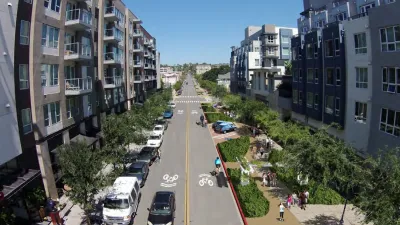Emily Badger of The Washington Post Wonkblog writes about a new study showing the economic benefits of converting street spaces in front of storefronts to parklets. Other options for street spaces include bike lanes, bikeshare docks, and bus lanes.

The piece is similar to the recent CityLab article by Eric Jaffe (posted here) that makes the economic case for converting street parking to bike lanes. Emily Badger's main target, though, is the parklet, a sidewalk extension into the street space that can provide a number of uses. "Most of them included tables, planters and bike racks that created something in between a new public park and an outdoor extension to nearby cafes and sandwich shops," writes Badger.
The study she writes about is the work of the University City District of Philadelphia, "a neighborhood development organization that sent interns out in the spring and summer of 2013 to exhaustively record what happened after a half-dozen of these tiny parks were placed."
The result: a lot more people packed into these spaces than could ever be accommodated by a single car.
Not all of these people were spending money at these nearby businesses (that's a good sign — it means that people recognized they could treat these spaces as public parks and not private outdoor restaurants). But the sales data shared by these businesses suggests that the extra foot traffic — and the outdoor attraction — was a boon for business, even when it came at the expense of a little parking.
The takeaway is that the study provides additional evidence "that a parking spot isn't always the best use of roadside real estate, although we often treat it as such," writes Badger. "And there are some signs that bikeshare docks boost business nearby, too," referencing a study done last year on Capital Bikeshare docking stations and effects on nearby business activity, also posted here.
FULL STORY: Why parking spaces shouldn’t always be wasted on cars

Maui's Vacation Rental Debate Turns Ugly
Verbal attacks, misinformation campaigns and fistfights plague a high-stakes debate to convert thousands of vacation rentals into long-term housing.

Planetizen Federal Action Tracker
A weekly monitor of how Trump’s orders and actions are impacting planners and planning in America.

In Urban Planning, AI Prompting Could be the New Design Thinking
Creativity has long been key to great urban design. What if we see AI as our new creative partner?

Cal Fire Chatbot Fails to Answer Basic Questions
An AI chatbot designed to provide information about wildfires can’t answer questions about evacuation orders, among other problems.

What Happens if Trump Kills Section 8?
The Trump admin aims to slash federal rental aid by nearly half and shift distribution to states. Experts warn this could spike homelessness and destabilize communities nationwide.

Sean Duffy Targets Rainbow Crosswalks in Road Safety Efforts
Despite evidence that colorful crosswalks actually improve intersection safety — and the lack of almost any crosswalks at all on the nation’s most dangerous arterial roads — U.S. Transportation Secretary Duffy is calling on states to remove them.
Urban Design for Planners 1: Software Tools
This six-course series explores essential urban design concepts using open source software and equips planners with the tools they need to participate fully in the urban design process.
Planning for Universal Design
Learn the tools for implementing Universal Design in planning regulations.
Appalachian Highlands Housing Partners
Gallatin County Department of Planning & Community Development
Heyer Gruel & Associates PA
Mpact (founded as Rail~Volution)
City of Camden Redevelopment Agency
City of Astoria
City of Portland
City of Laramie




























